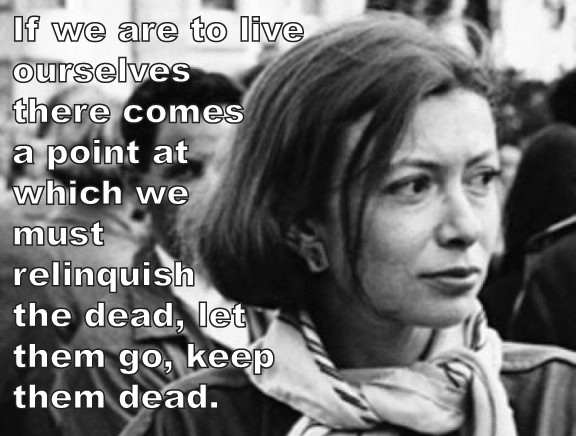 I hear there are people out there (though I’ve never been acquainted with one, so far as I know) who really believe high school was the best period of their lives. It’s a privilege to say so, but this position remains unfathomable to me. This isn’t to say I haven’t developed a retroactive appreciation for certain aspects of my teenage life; in high school I had no overhead, all of my income was discretionary, necessities (and sometimes luxuries) were provided for me, and activities like singing, debating, working on theatrical productions, shooting photography, and writing/editing for the school newspaper (awww, analogue blogging!) were considered “productive” uses of my time, all of which add up to a pretty cushy existence. Material and structural privilege can’t necessarily buy happiness, however, and it’s an understatement when I say that I’m presently happy to have left the affective experience of my teenage years in the past.
I hear there are people out there (though I’ve never been acquainted with one, so far as I know) who really believe high school was the best period of their lives. It’s a privilege to say so, but this position remains unfathomable to me. This isn’t to say I haven’t developed a retroactive appreciation for certain aspects of my teenage life; in high school I had no overhead, all of my income was discretionary, necessities (and sometimes luxuries) were provided for me, and activities like singing, debating, working on theatrical productions, shooting photography, and writing/editing for the school newspaper (awww, analogue blogging!) were considered “productive” uses of my time, all of which add up to a pretty cushy existence. Material and structural privilege can’t necessarily buy happiness, however, and it’s an understatement when I say that I’m presently happy to have left the affective experience of my teenage years in the past.
Recently, my Internet neighborhood has been revisiting high school through the lens of ‘What if we’d had Facebook Back In The Day?’ On Monday, Nathan Jurgenson (@nathanjurgenson) wrote about why we shouldn’t be so quick to celebrate the Facebooklessness of our adolescence; yesterday, Rob Horning (@marginalutility) posted his well-considered response. Below I consider both pieces, and add my own thoughts about the hypothetical intersections of present day Facebook and the pre-Facebook past. All three of us examine identity and “digital dirt,” but where Jurgenson considers embarrassment and stigma, and Horning considers context and narrative control, I consider temporality and affective experience.
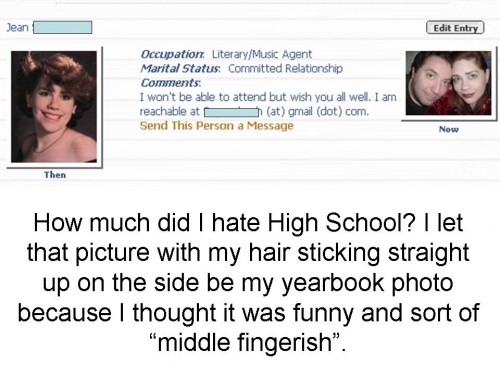 Jurgenson states that ‘I’m so glad we didn’t have Facebook back then’ (etc) is “a common refrain among people who grew up without social media sites,” and his argument against such statements is threefold. First, this sentiment takes for granted that the net impact of Facebook on young people’s lives is automatically negative. Second, it fails to take into account that a past-with-Facebook would have led to a different present; perhaps if we had grown up with Facebook, the consequences of past-Facebook that we fear now would be non-issues (either because our feelings or the world would be different).
Jurgenson states that ‘I’m so glad we didn’t have Facebook back then’ (etc) is “a common refrain among people who grew up without social media sites,” and his argument against such statements is threefold. First, this sentiment takes for granted that the net impact of Facebook on young people’s lives is automatically negative. Second, it fails to take into account that a past-with-Facebook would have led to a different present; perhaps if we had grown up with Facebook, the consequences of past-Facebook that we fear now would be non-issues (either because our feelings or the world would be different).
Third, and most importantly, Jurgenson is concerned that celebrating Facebooklessness reproduces the myth that identity is consistent and perpetuates the stigma against identity change. He suggests that, if we could all learn to live with a little “digital dirt,” there’s a slim chance that the coming ubiquity of documented adolescence might make it “very difficult to support the fiction of an identity that is unchanging, intrinsic, natural, or inevitable.” If identity were more broadly reconceptualized as fluid rather than fixed, Jurgenson hopes, perhaps society would also become “more tolerant of the non-normal and accepting of change and difference.”
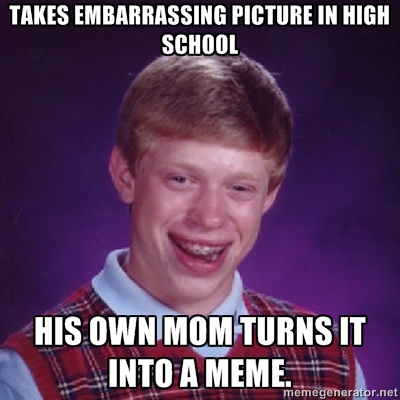 Horning, on the other hand, suggests that while Facebook does threaten to expose our identities as inconsistent or performative, what really frightens us about Facebook is that it decontextualizes our identity performances and “encourages the idea that identity isn’t embedded in context but is strictly a matter of data.” For Horning, identity change doesn’t automatically lead to stigma; as he rightly points out, identity change is both expected and glorified under its other name, “growing up.” The problem then isn’t the digital dirt; digital dirt, like other artifacts and traces left by past selves, is something our successive present selves can recontextualize in new narratives that reinforce, rather than undermine, our current identity projects. The problem is that Facebook not only makes our decontextualized digital dirt accessible, it also promotes the idea that context is superfluous. Facebook may invite you to “tell your story,” but the real message is that your story is irrelevant; each datum tells the truth of who you are, and no datum needs “context” to help it do so.
Horning, on the other hand, suggests that while Facebook does threaten to expose our identities as inconsistent or performative, what really frightens us about Facebook is that it decontextualizes our identity performances and “encourages the idea that identity isn’t embedded in context but is strictly a matter of data.” For Horning, identity change doesn’t automatically lead to stigma; as he rightly points out, identity change is both expected and glorified under its other name, “growing up.” The problem then isn’t the digital dirt; digital dirt, like other artifacts and traces left by past selves, is something our successive present selves can recontextualize in new narratives that reinforce, rather than undermine, our current identity projects. The problem is that Facebook not only makes our decontextualized digital dirt accessible, it also promotes the idea that context is superfluous. Facebook may invite you to “tell your story,” but the real message is that your story is irrelevant; each datum tells the truth of who you are, and no datum needs “context” to help it do so.
For Horning, Facebook therefore points in every direction except toward tolerance and acceptance of identity as fluid. It tries to actualize the myth of identity consistency by “[encouraging] us to become a stable, consistent target for marketers,” yet also “makes us vulnerable to having our identities ‘remixed’ by anyone who can access the identity information about us and verify we are connected to it somehow.” Horning fears that Facebook will lead not to a future in which we all inhabit one fluid identity that changes over time and across contexts, but in which we must each compete with and account for a proliferation of crystalized identities built “possibly by enemies, possibly by bots or algorithms” from the decontextualized digital data that Facebook makes available.
To knit both pieces together: Jurgenson and Horning agree (as do I) that identity consistency is a myth, and that it is impossible to achieve (no matter how hard one might try). Jurgenson suggests that celebrating past Facebooklessness perpetuates the myth of identity consistency, whereas if we give in to embarrassment and accept the “digital dirt” that leads us to celebrate past Facebooklessness, Facebook and its searchable timelines could help undermine the myth of identity consistency and thereby make digital dirt less of a liability in the first place. Horning, on the other hand, suggests that Facebook will both lead to a proliferation of crystalized identity-versions and intensify the degree to which digital dirt can discredit us. Both make a number of solid points (most of which aren’t actually in opposition to each other), but on the whole I side with Horning’s more pessimistic view. Though Jurgenson acknowledges that members of privileged groups would have to air their dirty digital laundry before digital dirt stopped harming “vulnerable populations,” it’s hard for me to imagine a world in which the privileged sitting with their embarrassment would have any impact on the *-isms that provide the real discrediting power that digital dirt has for Othered groups.
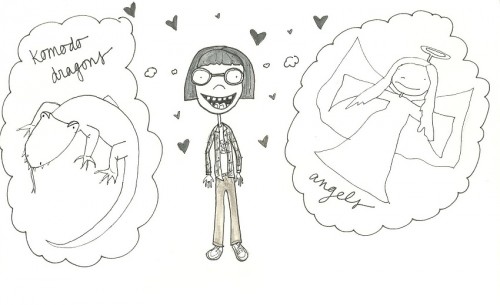
I want to suggest, however, that there’s more tied up in our imaginings of a hypothetical Facebooked past than just stigma and embarrassment, or context and narrative control (though these are certainly important things to interrogate). In particular, I want to focus on what Facebook Timeline does to our perceptions of time and to our experiences of the past. Jenny Davis (@Jup83) wrote last year about how Facebook Timeline extends the present into our pre-digital pasts, but by making artifacts from the past readily accessible, Facebook Timeline also brings both the digital and pre-digital pasts into the present.
In other words, while the documentary drive of social media may encourage us to see our present always as a future past, it also fixes our past always as a part of our present. I argue that while there is nothing new about identity change or potentially discrediting documentation of previous selves, the ease of accessing such documentation makes our past selves and our previous lives more presently salient not just to others, but to ourselves. To express relief at a Facebookless past, then, is also to express relief that some distance remains between that particular past and the present.
Is “telling your story” via Facebook Timeline any different from that old-school analogue method of chronicling one’s past, “journaling” or “keeping a diary”? Does it really drag the past that much more into the present? After all, Facebook Timeline is digital, and can be edited; I could reshape my Timeline narrative every week if I so chose, such that my past never showed anything beyond seamless, solid support for the self I claim to be now. In contrast, if I want to reshape the narratives in my paper journals, my choices are extremely limited—and mainly include scribbling out, tearing out, throwing out, or setting on fire. If we stop here, it might seem as though Facebook Timeline actually offers more control over the past’s relationship to the present than do older formats of self-documentation.
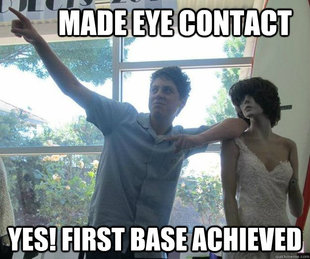 To stop there, however, is to forget that Facebook is both social and Social. I’m the only person who ever wrote in the ridiculous (and still expanding) collection of journals, diaries, notebooks, blank books, Moleskines, scratch paper, and paper scraps that I still cart around every time I move; suspicions about certain members of my immediate family aside, I’m probably the only person who’s ever read any of that stuff in its original format. Facebook Timeline, on the other hand, is collaborative; it’s not just me telling my story, it’s everyone who uploads a picture or tags me in a post or comments on my Wall.
To stop there, however, is to forget that Facebook is both social and Social. I’m the only person who ever wrote in the ridiculous (and still expanding) collection of journals, diaries, notebooks, blank books, Moleskines, scratch paper, and paper scraps that I still cart around every time I move; suspicions about certain members of my immediate family aside, I’m probably the only person who’s ever read any of that stuff in its original format. Facebook Timeline, on the other hand, is collaborative; it’s not just me telling my story, it’s everyone who uploads a picture or tags me in a post or comments on my Wall.
Facebook says this is a feature, not a flaw—that its architecture lets our friends help us remember—but this collectivization of authorship is a double-edged sword at best. I can untag myself, or hide things from my Wall, but I can’t delete anything I didn’t post; I can remove a photo’s presence from my Timeline, but I have to depend on your privacy settings to keep anyone from following the trail of breadcrumbs that leads from me, to our “friendship,” to you, to that photo of me that you won’t take down, even though we’re “friends.”
Similarly, I can delete and untag and re-edit all I want, but anyone with access (remember, access to my profile is not entirely within my control) can download images, and can take screen shots, and can save these things, and can launch them back into circulation long after I’ve deleted them from my version of my Timeline story. My Timeline, then, can spawn not just one but a range of uneditable narratives (as Horning points out).
Sure, a malicious person could also circulate uneditable narratives from my print journals. But circulating such material would require figuring out where I live, breaking into my house, determining which part of a chaotic box forest is harboring journal-fruit (good luck with that), carrying all that stuff back out through the box forest before I come home, actually reading through the material to find something scandalous, and then painstakingly transcribing or scanning the chosen passages in order to digitize them. We “Facebook-stalk” people because we’re bored and because doing so is easy; accessing my print journals would take a level of effort that I’m sure no one will ever manifest.
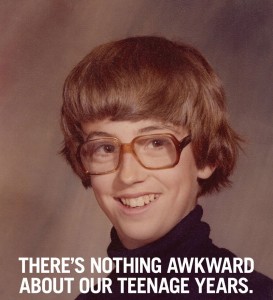 My purpose in sketching out these differences is not to be all IRL Fetish about paper journals (I also have more than 3,000 pages of downloaded digital journal on my computer, and that’s just from one particular platform). The point is that it’s comparatively much, much easier for others to interact with the Facebook Timeline version of my past (and to interact with it in multiple different ways) than it is for others to interact with versions of my past that have been documented in older media. This ease of access means that my Facebook Timeline past becomes more immediate not just to you, but also to me. Even if I mostly ignore the far end of my Timeline—even if I treat it the way I treat all those notebooks and journals I keep but rarely open—my Timeline past re-announces itself to me every time you interact with it.
My purpose in sketching out these differences is not to be all IRL Fetish about paper journals (I also have more than 3,000 pages of downloaded digital journal on my computer, and that’s just from one particular platform). The point is that it’s comparatively much, much easier for others to interact with the Facebook Timeline version of my past (and to interact with it in multiple different ways) than it is for others to interact with versions of my past that have been documented in older media. This ease of access means that my Facebook Timeline past becomes more immediate not just to you, but also to me. Even if I mostly ignore the far end of my Timeline—even if I treat it the way I treat all those notebooks and journals I keep but rarely open—my Timeline past re-announces itself to me every time you interact with it.
It’s been said that “nobody wants to see your status update from 2007,” but that isn’t always true. There’s the usual range of school admissions officers, prospective employers, obsessive stalkers, and the occasional malevolent dirt-seeker, but there’s also a practice I’ve taken to calling “timeline bombing”: I have one friend in particular who likes to scroll back and “like” items on the far ends of others’ timelines, just to see what those others’ reactions are when they get the notifications. Our Timeline pasts are dynamic, and lie even less dormant than do other versions of our past; they do not need us in order to stir and make themselves known.
We’ve argued all over Cyborgology—including in some of the posts I’ve already linked above—that social media affects both how we see the world and how we experience being in the world, even when we’re not using it and even if we never use it ourselves. It’s quite possible, then, that the temporal implosion intrinsic to social media generally, and to Facebook Timeline especially, might over time change our relationship to and experience of the past. I further argue that a Timelined past is particularly always a potential future present, and that traces of selves captured in Timeline format have a greater probability of resurfacing when we least expect them to do so.
Is this a bad thing? Jurgenson cites author Joan Didion, who advises us “to keep on nodding terms with the people we used to be, whether we find them attractive company or not.” Though I’m far more a fan of Didion than I am of Winston Churchill, one could also add, “those that fail to learn from history are doomed to repeat it.” Certainly there are many reasons not to disavow or cut ourselves off from our own pasts and our own past selves. But there’s also something to be said for leaving the past in the past (as much as is possible), and for meeting a past self for a quiet drink at a prearranged time, rather than running into clusters of past selves on the train, on our way to work, at a party, on a first date, or before an important talk.

My own gateway Didion text was her stark memoir The Year Of Magical Thinking, in which Didion reflects on the first year of her life after her husband, John Gregory Dunne, died suddenly of a heart attack. The book is an exquisite and intimate portrait of grief, of all the ups and downs and—yes—magical thinking that comes with learning to live a different life after losing a partner of 40 years. One thing that’s lingered with me years after reading The Year Of Magical Thinking, and which is relevant here, is the way grief seems to dislodge Didion in time.
As if in a movie cut on the digital editing machine she longs for in the book’s first pages, Didion’s consciousness quick-cuts from 2004 (the book’s present-day) to 1964, to 2003, to 2004 again, to 1978, to 1968, to 2004, to 1985—and makes far more stops. The 2004 Democratic National Convention in Boston becomes her daughter’s 2003 wedding in New York; a 2004 Boston hotel room becomes a 1955 Boston hotel room, becomes 1955 in Cambridge and Quebec and Sacramento, becomes California in 1966, becomes a blur of Hawai’i, Greece, Cyprus, Milan, Paris, Bogotá, and Buffalo, NY. “I couldn’t even go to Boston,” Didion concludes after this particular abduction down memory lane. Grief dissolves the mental boundaries between Didion’s past and her present; with the two so intertwined, even the most minute and quotidian details of life become flashpoints of pain and renewed loss. Only at the very, very end of the book—when she begins to let go and let Dunne become “the photograph on the table,” instead of trying to keep him still-living beside her—does Didion truly begin the difficult process of confronting the lonely future and creating a new life.
Facebook Timeline makes it much harder for our past lives and past selves to become “photographs on the table”—and this is why I, for one, am glad Facebook wasn’t around when I was in high school. Though I wouldn’t welcome it, I could handle the embarrassment; it must be news to no one that in many ways I was more shy, and far more awkward, and far, far worse at performing some semblance of being otherwise than I am now (which isn’t to imply that I didn’t make the attempt, but rather that the results probably alternated between “comedy” and “tragedy”). I’m even prepared to handle decontextualized recirculation; I’ve a library of stories to sketch a path from here to there, though obviously I’d rather not be forced into giving accounts. Self-presentation and self-documentation aren’t just about how we relate to others, however; they’re also about how we relate to ourselves.
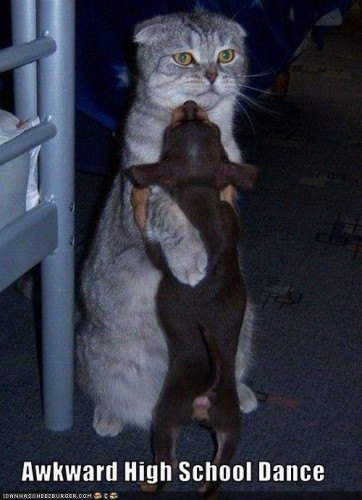 What I’m not prepared for, and what I’m grateful for not having to navigate, is a world in which my teenage experiences are anywhere near as immediate as they were half my life ago. There was far more to that time than naïve reasoning and unflattering photographs and poetry scrawled on napkins; there was also an incredible amount of pain, much of which had little to do with self-presentation. Though there are plenty of cringe-worthy moments I still remember, what I feel most strongly toward my past selves is not embarrassment, but overwhelming empathy and compassion—and that’s why those selves need to stay in the past. I’ve kept the photographs, and some VHS tapes; I’ve kept the notebooks, and the rough drafts, and the letters, and the printed-out email messages. I’ve kept all these things, but I keep them in boxes and in drawers and on shelves. My past selves and I don’t just nod, we stop and get coffee—but then we part ways for another six to twelve months, at least.
What I’m not prepared for, and what I’m grateful for not having to navigate, is a world in which my teenage experiences are anywhere near as immediate as they were half my life ago. There was far more to that time than naïve reasoning and unflattering photographs and poetry scrawled on napkins; there was also an incredible amount of pain, much of which had little to do with self-presentation. Though there are plenty of cringe-worthy moments I still remember, what I feel most strongly toward my past selves is not embarrassment, but overwhelming empathy and compassion—and that’s why those selves need to stay in the past. I’ve kept the photographs, and some VHS tapes; I’ve kept the notebooks, and the rough drafts, and the letters, and the printed-out email messages. I’ve kept all these things, but I keep them in boxes and in drawers and on shelves. My past selves and I don’t just nod, we stop and get coffee—but then we part ways for another six to twelve months, at least.
Certainly unwanted resurgences of the past are not unique to social media. For instance, just before I moved to California to begin graduate school, I was visited in Boston by a high school friend I hadn’t seen since the summer after our graduation. I don’t think she’d been in my apartment a whole 15 minutes, however, before she managed to bring up not only the most humiliating thing that happened to me in junior high school (it was bad), but also one of the worst things that happened to me in high school (it was far worse). The insult to injury was that her stories were inaccurate; things I’d still believed were secrets had apparently been decontextualized, had been cast in new lights and knit into new narratives, and had been circulating who knows how far for who knows how long. To my infinite chagrin, I was still shaken by this encounter days after the fact; though I kept telling myself, “It was ten years ago; you have nothing to do with that world; it doesn’t matter,” the memories remained stirred and the injustice insisted on mattering. I cannot imagine having this experience on a more frequent basis, but that’s probably what would have happened if there had been Facebook when I was in high school.
For a large number of people, and for a wide range of reasons, destabilizing the boundary between past and present threatens a lot more than just “today’s impeccably curated identity project[s].” Past selves bring with them past trauma, and past pain, things our present selves may have very good reasons for leaving in another time. Perhaps we should not be so breathlessly uncritical in our celebration of past Facebooklessness, but neither should we so readily criticize those who express relief that Facebook cannot easily dredge up what they have worked hard to move past. Some of us might be ‘hiding’ silly musical tastes or earlier political ignorance, but others of us are wrangling skeletons a bit more formidable than a stack of Creed CDs. Sure, let’s all celebrate our earlier Bourdieusian missteps (ask me sometime about going to my very first high school dance the fall after I learned “the Macarena” at summer camp). But as for the rest of it: let’s let sleeping memories lie.
Whitney Erin Boesel *loves* old traces of others’ past selves. You can share yours with her via Twitter: she’s @phenatypical.
Photo of Joan Didion from http://www.biographile.com/first-impressions-how-to-open-a-personal-essay/8757/; text from The Year Of Magical Thinking
“Middle fingerish” image from http://renovationtherapy.wordpress.com/2008/05/25/the-trauma-of-the-20-year-high-school-reunion/
Mom made a meme image from http://memegenerator.net/instance/18319351
Kimodo dragons and angels image from http://notacrazycatlady.com/2011/04/10/awkward-years-are-the-best-years/
Eye contact first base image from http://www.quickmeme.com/Romantically-Awkward-High-School-Student/?upcoming
Awkward teenage years image from http://www.singletracks.com/blog/uncategorized/high-school-hormones-and-singletrack/attachment/awkward/
Rooftop photograph taken by Elizabeth Johnson in the 1990s; scanned sometime in the aughts.
Awkward highschool dance image from http://cheezburger.com/3115771904

Comments 20
Mike — November 29, 2012
When I wrote awhile back on similar matters, I thought it well to conclude with this from Derrida:
“They tell, and here is the enigma, that those consulting the oracle of Trophonios in Boetia found there two springs and were supposed to drink from each, from the spring of memory and from the spring of forgetting.”
jennydavis — November 29, 2012
LOVE this Whitney. I think this is such a fruitful debate and so well argued from all sides by you, Nathan, and Rob.
One more complexity: You note that Facebook offers greater technical control over representations of the past, but also that this past is co-constructed, reducing control in new ways. I would add to this that the act of deleting and re-curating is a strong authenticity threat. It is an act of explicit recognition that the self is performative. To engage in such an act through Facebook is to document performativity in a social way. This is quite a big step and I would argue, a huge impediment to control.
Thirteen Ways of Looking at Livejournal » Cyborgology — November 29, 2012
[...] Livejournal entries. They are there, I can’t delete them, because it feels like dishonesty. But when I summon the courage to look back at any of them, it feels like being skinned alive. I was so raw and foolish; to read the words that came from that person is to be that person again. [...]
quiet riot girl — November 29, 2012
I was only on facebook briefly. And after I had left, the timeline feature further solidified my resolve not to go back. Because my past is not a linear narrative, I can't and won't tell it that way. I have no problem dealing with and recording the past but not in such a set way imposed on me by a social media corporation.
I also think that we should acknowledge the 'facebooklessness' of some people even in the facebook age. I know we are still influenced by such a big phenomenon even if we don't sign up, but I still consider myself able to avoid many of the aspects of facebook you describe here, simply by not being on it. And especially when those of us not on facebook are finding other ways to 'perform' ourselves - on twitter, blogs, in journals, books, conversations, youtube videos, and other ways I don't even know about!
Elly/QRG
Dim — November 29, 2012
The assumption I have trouble with here is that bringing these old difficult memories back up unbidden would be a bad thing.
I had Facebook in highschool, and a the series of events that lead to my attempted suicide had a habit of resurfacing at the worst of times, and continued to do so until fairly recently. This definitely seemed like a bad thing at the time, but I no longer think so. My belief is that I have resolved more of my issues faster because I couldn't hide. Perhaps this is another one of those instances where how this affects you is up to you. With the exception of how others will act with your information, that’s another can o’ worms/
Our past, with or without Facebook | Lessons in Learning — November 29, 2012
[...] I’ve been following a lively and very interesting examination (this blog post links to other posts that deal with both sides of the issue) of the fluidity [...]
Memory, Facebook, and the Narrative Unity of a Life « The Frailest Thing — November 29, 2012
[...] “Let Sleeping Memories Lie: High School and the Facebookless Past” by Whitney Erin Boesel [...]
Time was the end of Facebook fun: The past, the future, and the self | milieuXmorass — November 30, 2012
[...] a great series of essays about, broadly, the self on Facebook by Nathan Jurgenson, Rob Horning, and Whitney Erin Boesel. They’ve given more careful thought to these issues and you really should read their essays [...]
Friday Roundup: November 30, 2012 » The Editors' Desk — November 30, 2012
[...] (if interest convergence theory and an Internet blackout are any indication), and Jurgenson and Whitney Erin Boesel both consider the legacy of high school before [...]
Ray — December 1, 2012
I don't get the Bourdieu reference... but I never studied further than high school
Difference Without Dualism, Pt 2 (of 3) » Cyborgology — March 29, 2013
[...] documented, on how social media might affect how we understand friendship or how we feel about our own past selves, and about the complex relationships between technology and subjective experience within the [...]
QuantBaby: The Birth of a Datababe » Cyborgology — July 11, 2013
[...] my empathy and fear of losing my identity have made equally effective documentary drives. Among the things I dragged to California and back again are small boxes of ticket stubs, received letters, old journals, longhand rough drafts, scrawled-on [...]
What’s In A (User)Name? » Cyborgology — July 25, 2013
[...] all of those things. As a sociologist, I’m on board with the fact that [LINKS] identity is neither stable nor a linear narrative, and yet more so than in most other years, I feel like I left 2012 markedly [...]
Sextual Healing » Cyborgology — September 4, 2013
[...] a result, I spent my teenage years on the cusp of being what we now think of as “connected”—I journaled on paper but wrote poetry on computers (also napkins); I wrote letter-length notes during class but sent [...]